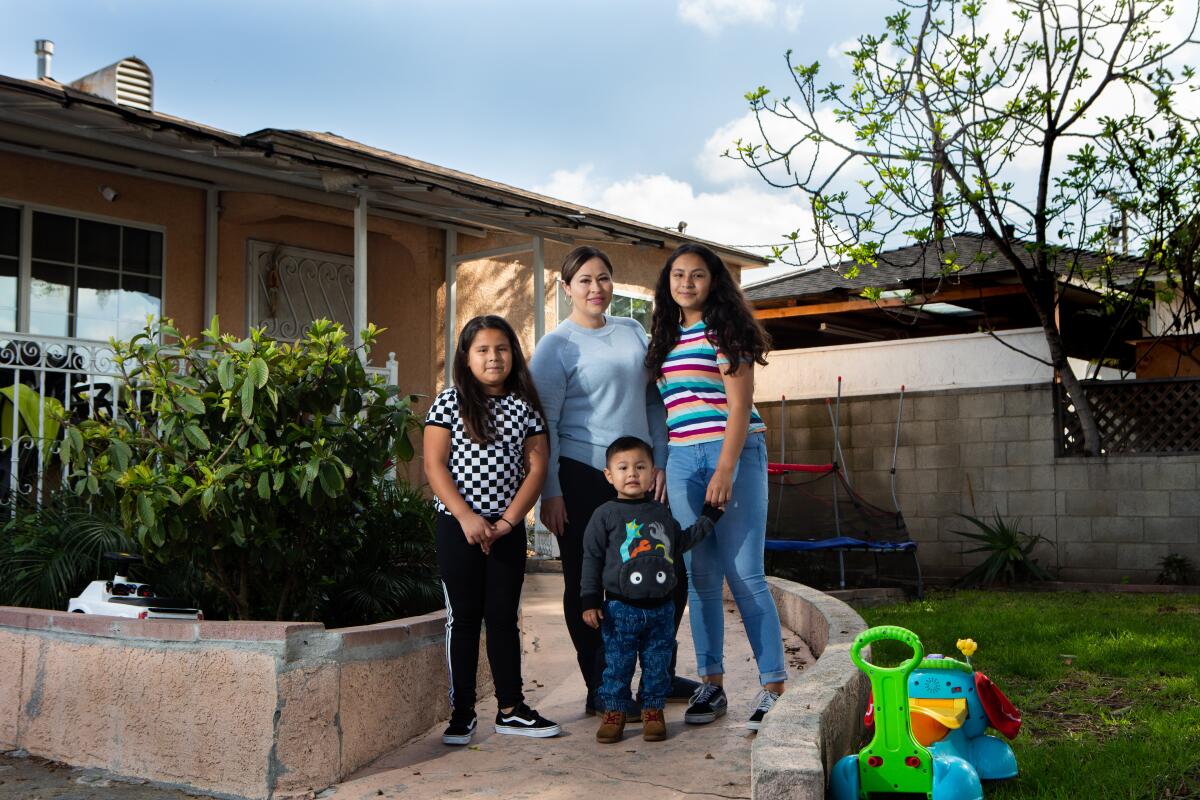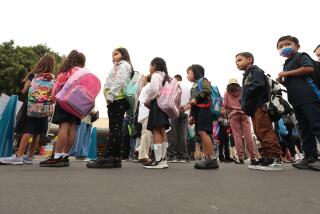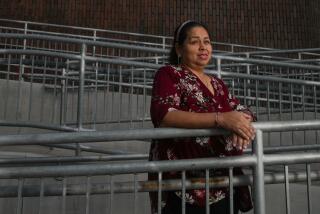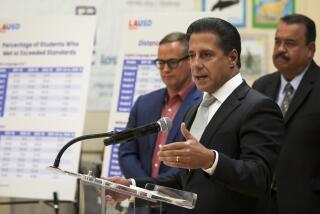Ds and Fs surge, attendance slips among L.A.’s poorest students amid distance learning

Grades of D and F have increased in the Los Angeles Unified School District among middle and high school students in a troubling sign of the toll that distance learning — and the coronavirus crisis — is taking on children, especially those who are members of low-income families.
The drop in grades, which also is affecting other school systems, was disclosed Monday when L.A. Unified released a chart based on 10-week interim assessments. Poor grades surged in the district’s lower-income communities, which also is where student attendance rates are lower and where the COVID-19 pandemic has hit especially hard.
“The attendance figures and interim assessments don’t reflect the desire or capability of students,” said L.A. schools Supt. Austin Beutner in remarks broadcast Monday. “They’re eager to learn and every bit as capable as they were before school facilities closed. But the struggle to cope with COVID-19 and online learning for children and their families is very real.”
The data on grades made another announcement all the more painful, even though school board leaders foreshadowed it last week: Campuses will not reopen for most students before January, the superintendent said. And even that timing could prove doubtful, Beutner said, unless the coronavirus pandemic subsides and unless state and local agencies offer more guidance and resources.
The drop in grades suggests that “traditional ways of measuring learning need rethinking,” said Janelle Scott, a professor in the Graduate School of Education and African American Studies department at UC Berkeley. “Grading students right now is essentially grading their home resources, which includes not only the physical structure and availability of a space to ‘do’ school, but also adults who can support and supplement remote offerings.”
The dropping grades provide more evidence about the pandemic’s harm to education, said Elisha Smith Arrillaga, executive director of Education Trust–West, an Oakland-based research and advocacy group.
“This significantly complicates high school graduation, college and career preparation, and college admissions,” she said. “California’s students will be experiencing the impact of COVID-19 for years to come.”
Teresa Rodríguez’s son, Iván, a ninth-grader at Bell High School, has never brought home a failing grade, but so far, he’s got an F in theater. His other grades are better, but Rodríguez worries about his academic malaise.
“There are days when he tells me he doesn’t even want to log on,” she said. “I force him, of course. But it’s all very negative. And he’s always taking bathroom breaks.”
She worries about his changed attitude toward learning and, down the road, about college.
“He was so excited to graduate from middle school,” Rodríguez said. “He was looking forward to walking by himself to school, making new friends, having a new pace of life. And he lost all of that.”
Rodríguez understands there are no easy answers — and, even if she could, she’s not sure she’s ready to send her children back to campus because of family health issues.
The grades of Keyla Quijas, a seventh-grader at the Maywood Center for Enriched Studies, have slipped from A’s and Bs to Cs, Ds and Fs, said her mother, Norma Quijas.
“I’ve talked to her about her grades, and she said, ‘Mom, it’s not the same thing to be at home as at school,’” said her mother. “I feel she’s not learning at all. It’s stressful for me. I sit there with her. I know teachers are trying their best, but it’s not the same thing.”
Quijas also has a daughter in third grade: “They lose interest after a couple of hours of sitting down at the computer.”
Declining grades also have surfaced in Carlsbad Unified, a San Diego County school system that has less than a third as many students living in poverty as L.A. Unified. The percentage of Ds and Fs in Carlsbad has more than doubled, rising to 14.3%, said Supt. Benjamin Churchill.
Similar surges in failing grades are being reported among school systems in the San Francisco Bay Area.
Unlike some school systems, L.A. did not release the numbers behind the year-to-year increases in Ds and Fs.
For all districts, the 10-week report serves as an early warning system that teachers and district officials are using to target assistance for struggling students.
Beutner announced on Monday that L.A. Unified is expanding from one-on-one in-person tutoring to groups of up to three — to reach more students. All participants, including teachers, will have to take a coronavirus test, even if they’ve had one recently. This gradual growth of in-person services is expected to reach several thousand of the district’s 460,000 K-12 students. Health authorities allow in-person services to students with special needs, up to 25% of enrollment.
The district also will be speeding up the in-person assessment of students with special needs and will allow sports teams to begin conditioning work — outside with physical distancing and no team drills. These expanded activities arise from new agreements with United Teachers Los Angeles, which represents teachers, nurses, counselors and librarians.
The next two months need to be spent in an all-out effort to get ready for a hoped-for January opening, Beutner said
As part of that effort, L.A. Unified joined six other large California school districts Monday in calling on state and local officials to develop “a common standard of health, education and employee practices so schools have a clear path to open in the safest way.”
The districts called for “regular surveillance testing” for the virus among students and staff at no cost to participants or school districts. They also called for plans to help employees who would be at risk by returning to campus or who would put a family member at risk by doing so.
State legislators expressed overlapping concerns in a Monday letter to Mark Ghaly, the secretary for the state Health & Human Services Agency.
State officials last week could not tell the Assembly education committee which California schools have reopened or have had outbreaks of COVID-19 — let alone factors that would have contributed to an infection in a school community.
Such data should be collected and analyzed, said Assemblyman Patrick O’Donnell (D-Long Beach), who cosigned the letter.
Beutner called the failure to collect such data “reckless” and pointed to ongoing efforts by L.A. Unified to tally and post its own testing data.
A report from the state’s legislative analyst said various state and county agencies are providing sometimes conflicting guidance to schools on how best to keep campuses safe.
State COVID rules stipulate that Los Angeles County cannot open public and private K-12 campuses to all students because coronavirus infection rates are too high, with the county in the state’s most restrictive purple Tier 1. In contrast, campuses in Orange, San Diego and Ventura counties, where infection rates are lower, are clear to open.
Campuses in San Bernardino County cannot open. In Riverside County, campuses also must remain closed unless they were able to open before a recent spike of COVID cases in that county.
“First things first,” said Beutner. “The overall level of COVID in this community has to be at a safer level... There’s nobody more frustrated by this than I.”
The situation with student grades embodies this frustration.
“It’s not their fault, their families’ fault or the teacher’s fault,” he added.
In the spring, L.A. Unified joined some other California districts in giving students a passing grade in all classes. And no grade was lowered after campuses shut down on March 13. Since then, L.A. Unified has worked to make online learning universally accessible, to provide a consistent course schedule and to create more engaging online lessons. L.A. teachers have taken multiple training sessions in online instruction, while also modifying lesson plans and courses.
And grading has resumed.
“Extraordinary things are happening in classrooms,” Beutner said. “But the simple fact is some students are struggling online.”
Even some significant accomplishments have been tempered by reality. The district’s universal access efforts — making computers and internet hot spots available to all students — have been undermined by pockets of inadequate Wi-Fi reception across the county, especially in lower-income areas.
In the “highest-needs communities,” Beutner said in the interview, “the struggle is more difficult. He noted that the Wi-Fi signal “may not be as strong in parts of the communities as in others.”
Beutner said he spoke with a dedicated and “heartbroken” middle school teacher who talked about students who are late to class, who turn off screens during a Zoom class, who don’t turn in assignments and of families that don’t return calls.
“He knows most of these students would be doing better in a classroom at school with the structure it provides, the comfort of friends and the focus and routine of his teaching,” Beutner said.
More to Read
Sign up for Essential California
The most important California stories and recommendations in your inbox every morning.
You may occasionally receive promotional content from the Los Angeles Times.












